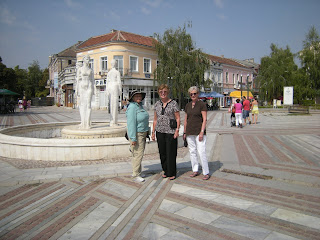Tuesday brings us to Bulgaria. We visited the river port city of Vidin, which is about 2,000 years old. It was founded by the Romans and periodically people digging in their gardens find Roman coins or pottery. Vidin was on the road from Constantinople to Rome. The Turks controlled this area for about 500 years. They left towards the end of the 19th century. In the distance is the half finished bridge between Bulgaria and Romania. The Bulgarian side is complete, but the Romanians are dragging their feet. They wanted the bridge in a different location. Vidin is a very poor city. Its population shrank from 80,000 to 40,000. Everything looks like it could use some restoration. It is hoped that the bridge would help the economy of the city.
The rose is the national flower of Bulgaria.
We went to see the fortress. It was originally built by the Romans, rebuilt by the Bulgars, rebuilt by the Turks and then rebuilt by the Bulgars after the Turks left. One of the towers has a picture of the sun on it. That tower was built for the king, who was defeated by the Turks in 1396. They tell the story of a king who had no sons but three daughters. He wanted his daughters to marry and produce sons. The two youngest married but the marriages were disasters. The oldest refused to marry and inherited the city from her father. She was known as Baba Vida. Baba means grandmother and in this situation is used as a sign of respect. Apparently she ruled well and long. There is a sculpture in the city called the three sisters.
The fortress is popular with movie makers and usually at least one film a year is made there.
We passed the ruins of the Synagogue which was the second largest synagogue in Bulgaria. It is a ruin because the Jewish population left for Israel. The Jewish population of Bulgaria was saved by a combination of the Orthodox Church, the government and the people. Not one Bulgarian Jew died during the holocaust.
 Arriving in Vidin, Bulgaria
Arriving in Vidin, Bulgaria Building in Vidin
Building in Vidin Half Built Bridge
Half Built Bridge Protective wall around city
Protective wall around city Monument to liberty built by the soviets
Monument to liberty built by the soviets Roses for which Bulgaria was at one time famous
Roses for which Bulgaria was at one time famous Wall around fortress
Wall around fortress Tower with Sun indicating that the King lived there
Tower with Sun indicating that the King lived there View of fortress
View of fortress Entrance to fortress
Entrance to fortress Me in front of the fortress
Me in front of the fortress Inside the fortress
Inside the fortress Entrance to armory
Entrance to armory In armory
In armory Cannon on walls
Cannon on walls View of river from fortress
View of river from fortress Hole to somewhere
Hole to somewhere Me on Cannon
Me on Cannon Me on Cannon
Me on Cannon Looking out of fortress
Looking out of fortress Map of fortress - blue is Roman, yellow is Austrian,
Map of fortress - blue is Roman, yellow is Austrian, Remains of Synagogue of Vidin
Remains of Synagogue of Vidin Another view of Synagogue remains
Another view of Synagogue remains remaining Star of David - also window remnant contains Star of David
remaining Star of David - also window remnant contains Star of David Remains of windows
Remains of windows Mosque Library
Mosque Library Only remaining Mosque in operation in Vidin
Only remaining Mosque in operation in Vidin Monument outside of Serbian Orthodox Church
Monument outside of Serbian Orthodox Church Serbian Orthodox Church
Serbian Orthodox Church Entering center of city via the main gate probably built by the Turks
Entering center of city via the main gate probably built by the Turks Momument of Appreciation from the Jewish Community to the citizens of Vidin
Momument of Appreciation from the Jewish Community to the citizens of Vidin Me in front of the momument
Me in front of the momument Our guides - Dushan who was the tour leader and Manuela who was the local guide in Vidin
Our guides - Dushan who was the tour leader and Manuela who was the local guide in Vidin The three sisters
The three sisters Vidin street scene
Vidin street scene Vidin street scene
Vidin street scene Vidin Street Scene
Vidin Street Scene Vidin street Scene
Vidin street Scene Me, Beverly and Carolyn in front of three sisters
Me, Beverly and Carolyn in front of three sisters Monument to those who died in the Balkan Wars around 1920
Monument to those who died in the Balkan Wars around 1920 Street Scene in Vidin
Street Scene in Vidin Sculpture in park
Sculpture in park Scene along Danube - people swimming in river
Scene along Danube - people swimming in river Scene along the Danube
Scene along the Danube
No comments:
Post a Comment